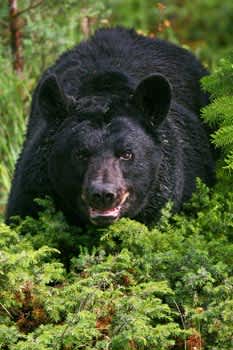Possible Bear Hunting Changes in Utah
OutdoorHub 11.28.11

If you like to hunt bears, you might have opportunities in 2012 that you’ve never had before in Utah.
A new bear management plan is making the new opportunities possible. The Utah Wildlife Board approved the plan earlier this year.
John Shivik, game mammals coordinator for the Division of Wildlife Resources, says the plan has opened the door to some new hunting options. “At the same time,” Shivik says, “the plan provides some important safeguards to keep the state’s bear populations healthy and safe.”
All of the changes the DWR is recommending for Utah’s 2012 bear hunts are available online. The following are some highlights:
- Currently, most of the bears that are hunted in Utah are tracked by hounds and ran up trees. A few hunters hunt over bait using a bow and arrow. But starting in 2012, biologists are recommending that spot-and-stalk-only hunts be held in some areas in Utah.
Hunters may not use hounds or bait during spot-and-stalk hunts.
- Currently, all of Utah’s bear hunting areas are limited-entry areas. Only those who draw a permit for a limited-entry area can hunt on it.
Starting in 2012, biologists would like to offer some harvest-objective hunts too.
The number of hunters who can hunt on a harvest-objective area isn’t limited, so switching an area to harvest objective gives more people a chance to hunt the area. Letting more hunters hunt an area increases the chance that more bears will be taken.
As soon as a predetermined number of bears are taken (called the area’s quota), the hunt on the area will end for the season.
- The spring hunts on some of Utah’s bear hunting units might run a little longer in 2012. Having longer spring seasons allows biologists to put more pressure on bears in areas where bears often kill livestock and raid campgrounds.
Protecting the bears
In addition to opening the door to some new hunting opportunities, the new plan provides bears with some important safeguards:
- In the past, Shivik says biologists have used three factors to determine the health of Utah’s bear population—the percentage of bears taken by hunters that are female, the average age of the bears taken and the number of adult bears that survive in Utah from year to year.
- You won’t find those three factors in the new plan. Instead, biologists will focus on two key factors: the amount of female bears and the amount of adult males taken by hunters.
(An adult male bear is a bear that’s five years of age or older.)
Shivik says the number of females and the number of adult males that hunters take gives important information about how a bear population is doing:
- The number of females hunters take is important because females give birth to cubs and then care for the cubs after they’re born.
- “But the number of adult males hunters take is the best early indicator we have about the health of a bear population,” Shivik says.
Shivik says adult males wander more than the other age groups. Because they wander more, adult males are the bears hunters usually encounter and take.
If biologists see that the number of adult males hunters are taking is going down—and the number of females is going up—they know the bear population in the area is in decline.
“Once hunters start finding females, instead of the males they normally encounter first,” Shivik says, “we know the population is declining in number.”
In addition to the number of female bears and adult male bears hunters take, biologists are also using two important bear studies to determine the health of Utah’s bear population:
- One study involves snagging hair from bears at sites across Utah. After the hair is snagged, DNA tests are used to determine how often the bears that left the snagged hair are visiting the sites. This study is helping biologists measure how fast or slow the state’s bear populations are growing.
- In the second study, biologists visit bear dens in the winter to see how many cubs are in the dens and to assess the health of the cubs and their mothers.
This study is giving biologists important information about the number of bears that are being brought into Utah’s population each year.
Learn more, share your ideas
After you’ve reviewed the DWR’s ideas, you can let your Regional Advisory Council members know your thoughts by attending your upcoming RAC meeting or by sending an email to them.
RAC chairmen will share the input they receive with members of the Utah Wildlife Board. The board will meet in Salt Lake City on Jan. 12 to approve rules for Utah’s 2012 bear hunting and pursuit seasons.
Dates, times and locations for the RAC meetings are as follows:
- Southern Region
Dec. 6, 7 p.m.
Beaver High School
195 E Center Street, Beaver
- Southeastern Region
Dec. 7, 6:30 p.m.
John Wesley Powell Museum
1765 E Main Street, Green River
- Northeastern Region
Dec. 8, 6:30 p.m.
Bingham Entrepreneurship and Energy Research Center
320 N Aggie Blvd (2000 W), Vernal
- Central Region
Dec. 13, 6:30 p.m.
Central Region Conference Center
1115 N Main Street, Springville
- Northern Region
Dec. 14, 6 p.m.
Weber State University, Shepherd Union Building, Rooms 404A and 404B
3848 Harrison Blvd, Ogden

